Mesoporous Ni@C hybrids for a high energy aqueous asymmetric supercapacitor device†
Abstract
An advanced asymmetric supercapacitor device (ASC) with high energy density was successfully fabricated by using a three-dimensional (3D) core–shell Ni@C hybrid as the positive electrode and activated carbon (AC) as the negative electrode. In addition, the Ni@C hybrid exhibited a one-dimensional (1D) morphology as a whole and a 3D core–shell nanostructure in details. The Ni@C hybrid was subtly controlled down to 10 nm scale to achieve a large exposed exterior surface and a remitting diffusion-controlled ion transference process. Moreover, the 1D porous texture and Ni-decoration of the Ni@C hybrids improved the supercapacitive performance enormously, with an ultrathin carbon shell ensuring a large external active surface and high electrical conductivity. Due to its unique core–shell structure, the Ni@C hybrid electrode delivered a high 2006 F g−1 capacitance at 1 A g−1, and still retained a high 1582 F g−1 capacitance with the current density increasing up to 20 A g−1. Coupled with the AC negative electrode, the ASC device delivered a 152.7 F g−1 capacitance at 1 A g−1 and 99 F g−1 at 10 A g−1. The capacitance retention reached up to 91% after 2000 cycles at a 1 A g−1 current density. In addition, the ASC device delivered a maximum 61.3 W h kg−1 energy density with a 1.6 V operational voltage, which could remain at 39.8 W h kg−1 even at a 1.12 kW kg−1 power density, suggesting promising future applications.


 Please wait while we load your content...
Please wait while we load your content...